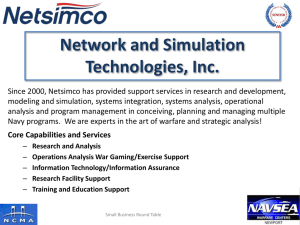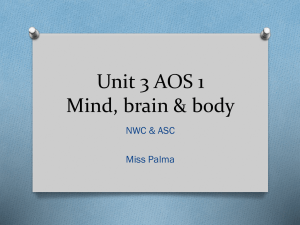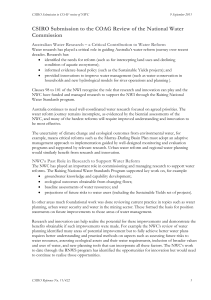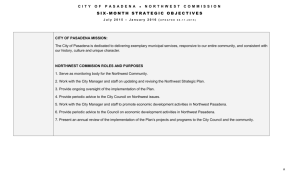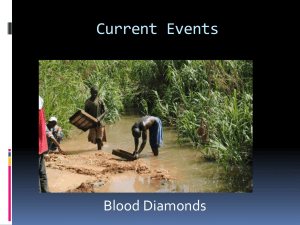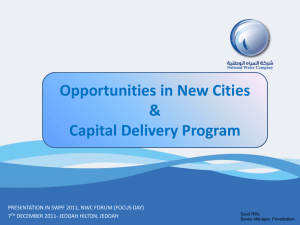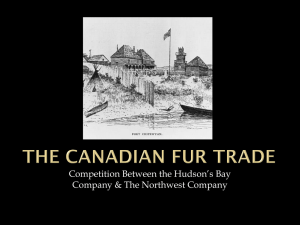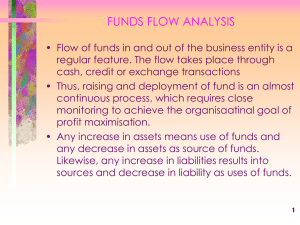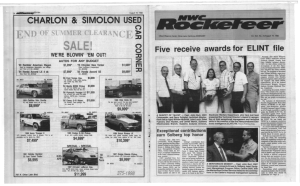National Water Company
advertisement
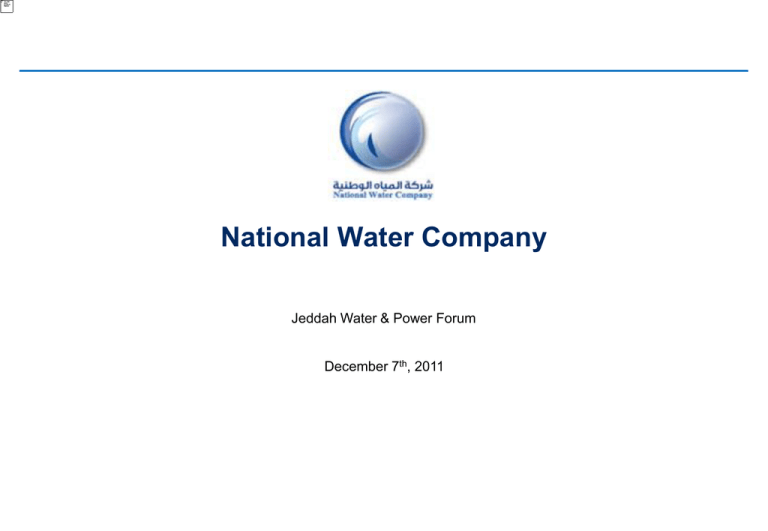
National Water Company Jeddah Water & Power Forum December 7th, 2011 Agenda • NWC Challenges and Strategic Roadmap • NWC Business Development Initiatives • NWC Expansion Plan Strategic Planning 2 Saudi Water and Wastewater Sector is facing numerous challenges Poor Infrastructure Ageing assets with unplanned interruptions High levels of leakage More focus on capital than operational expenditure (maintenance) Shortages in Water Supply Limited Sewerage Collection Environmental Issues Unsatisfactory Customer Service Water rationing due to demand/supply gap Low water pressure in network Incomplete network coverage Suboptimal reliability of distribution Low collection network coverage Need to cater for increasing water supply and consumption High water spillages No control over industrial effluent Sub-standard TSE quality Inadequate sludge disposal practices Complex complaint management Service not customer oriented Delays in connecting customers to networks Suboptimal Operational Costs Inefficiencies in supply management and raw material consumption Suboptimal staffing levels and compensation High Capital Expenditures High capex requirements to meet water demand, expand sewerage networks and increase treatment capacity Suboptimal project management High Non Revenue Water and Low Collection Rates Inefficient Organization, Processes and Staff Development Incomplete Data High unaccounted for water levels Low tariff collection Lengthy processes, especially planning, contracting and procurement Inadequate asset management Limited automation Limited staff development and motivation Inaccurate data on the state of the infrastructure, particularly leakages Limited tracking of key performance indicators Strategic Planning 3 Rising per capita consumption, together with population growth is leading to rapidly increasing the existing water demand and supply gap Per Capita Water Supply 1) Projected Water Supply By City2) In liters/capita/day 2010-2015, in thousand m3/day 5,420 4,265 4,546 5,422 Greater Dammam Madinah 4,549 3,859 Makkah/Taif Jeddah Riyadh 1) 2) Total water supply divided by the population of the city Total required daily supply to meet average daily demand (assuming improving supply continuity coupled with reduction in water losses) Strategic Planning 4 A clear strategic roadmap has been developed with five transformation themes to drive performance and health of NWC “A world-class water utility company” Vision A World-class operator Performance pillars Health foundations (enablers for the future) B C Financially sustainable water business Shaper of water sector in KSA D Streamlined organization structure with strong performance culture E Developing distinctive capabilities that will provide a competitive edge Strategic Planning 5 Agenda • NWC Challenges and Strategic Roadmap • NWC Business Development Initiatives • NWC Expansion Plan Strategic Planning 6 NWC is working on various initiatives aiming at establishing new profitable businesses to become financially sustainable Main Business Development Initiatives Initiatives Key Objectives Position NWC as a leading O&M player, allowing opportunities to compete regionally O&M (Operations & Maintenance) Reduce O&M costs/ promote Saudization Expected to improve customer service and may harmonize processes and systems across cities within a cluster TSE Effectively utilize waste water resources (Treated Sewage effluent) Create a profitable TSE business Strategic Planning 7 Agenda • NWC Challenges and Strategic Roadmap • NWC Business Development Initiatives • NWC Expansion Plan Strategic Planning 8 City selection requirements were formulated based on the selected PPP models and NWC’s objectives City Selection Requirements Selection Criteria Description Implications Economic Efficiency Cities with higher revenue potential and lower operating expenditure are preferred to ensure financial sustainability Select cities with the highest economic efficiency under NWC for the period 20122020 Infrastructure Development NWC should decrease its dependency on capex-related government subsidies and minimize the complexity of managing capital projects in order to reduce project delays and attract the private sector Select cities with the relatively better infrastructure conditions, requiring the least intensive capital investment 1) Conservative, non-comprehensive estimates designed for city ranking purpose only Strategic Planning 9 The evaluation of cities based on infrastructure development and economic efficiency, results in the following city prioritization City Selection Matrix Selection of Metropolitan Cities Infrastructure Development Cities Mapping Metropolitan City Tabuk Yanbu Hofuf & Mubaraz Al Kharj Contribution Cumulative To National National Pop Pop Coverage Coverage1) 1. Greater Dammam 5.1% 51.1% 2. Yanbu 0.9% 52.0% 3. Tabuk 1.9% 53.9% 4. Hofuf & Mubaraz 3.0% 56.9% 5. Buraidah & Onaizah 2.3% 59.2% 6. Al Kharj 1.2% 60.4% 7. Hafr El Baten 1.2% 61.6% 8. Najran 1.2% 62.8% 9. Khamis Mushait & Abha 2.5% 65.3% 10. Hail 1.2% 66.5% Madinah Greater Dammam Buraidah & Onaizah Khamis Mushait & Abha Hail Najran Hafr El Baten Cost Recovery 1) Including Riyadh, Jeddah, Makkah/Taif and Madinah contributing 18.7 %, 13.1 %, 9.8% and 4.4% respectively to national coverage Strategic Planning 10 Clustering cities promotes scale efficiencies, balanced competition, service consistency and control City Clustering Advantages Advantages Economies of Scale and Scope Balanced Competition Customer Service Consistency Better Control Description Aggregation creates efficiencies such as shared overhead Staff exchange, expertise and knowledge sharing between cities of the same cluster would fill gaps in skills and capabilities and reduce ramp-up period upon privatization Allocation of clusters of equivalent operational scale to the operating companies would facilitate comparison and benchmarking of performance between private operators Having the same operator across different directorates will reduce customer service discrepancies between covered cities Granting fewer contracts minimizes the effort required for monitoring the performance of contractors Strategic Planning 11 Operating contracts could be granted by regional cluster to improve the offer to private players and decrease complexity for NWC Distribution of Cities Across KSA Suggested Regional Clusters (Cities in Grey not needed for 60% National Coverage) Including City Ranking Based on Overall Ranking in Attractiveness Matrix Hail Province Tabuk Province Hafr El Baten Tabuk Hail Buraidah & Onaizah Madinah Province Yanbu Makkah Province Jeddah Riyadh Madinah Al-Kharj Greater Dammam Hofuf & Mubarraz Clustering Methodology Eastern Province Makkah & Taif Khamis Mushait & Abha Asir Province Qassim Province Najran Najran Province Fourteen metropolitan cities were first assigned to their different provinces (9) across the Kingdom = Part of the 60% target national coverage = Not part of the 60% target national coverage Hafr El Baten Buraidah & Onaizah Greater Dammam Riyadh Hofuf & Madinah Mubarraz Yanbu Al-Kharj Makkah Jeddah & Taif Tabuk Khamis Mushait & Abha Hail Najran Then, grouping of neighboring administrative regions into clusters of equivalent operational scale and evaluation of clustering options resulted in the selection of the 4-cluster configuration Strategic Planning 12 This privatization growth strategy is fully in line with NWC vision Proposed Privatization Growth Objectives Customer Service Financial Sustainability National Coverage Economic Development Saudization Improve operations (e.g. rationing) Increase service levels and customer satisfaction Introduce new technologies that improve efficiency and performance Minimize dependence on government subsidies through rationalizing capital and operational expenditures and increasing revenues and collection Become the dominant player in the water and wastewater sector in Saudi Arabia Cover more than 60% of the population within the next 10 years by taking over select metropolitan cities Encourage competition in the sector Ensure high transparency and accountability Promote advanced privatization models Contribute to the employment and development of Saudi nationals Optimize the use of the national workforce Operating Model Support the evolvement of NWC into a holding company Provide support or transactional services, subject to economies of scale, through shared services Knowledge Transfer and Development of Capabilities Bring knowledge of international best practices Develop and build on existing operational and management capabilities (e.g. asset management) Strategic Planning 13 NWC has defined the key success factors for the privatization growth strategy along three dimensions Privatization Growth Strategy Key Success Factors A Contract Definition and Management Appropriate allocation of risks and comprehensive contract terms Accurate baseline and achievable performance indicators B C Government Support Timely availability of funding Enforcement of TSE regulations and groundwater abstraction policies to promote wider TSE usage Organization and Capabilities Restructuring of NWC to better manage its growth (review of operating model, organization structure, governance and processes) Development of competencies Proper control post contract signature Improved project management capabilities Management of public expectations from contracts Systematic knowledge transfer across the organization Strategic Planning 14 Thank You Strategic Planning 15

